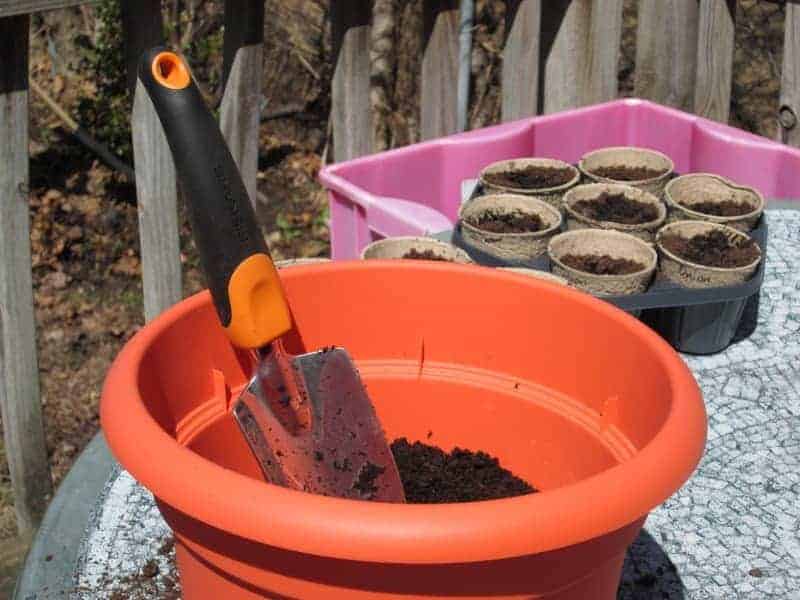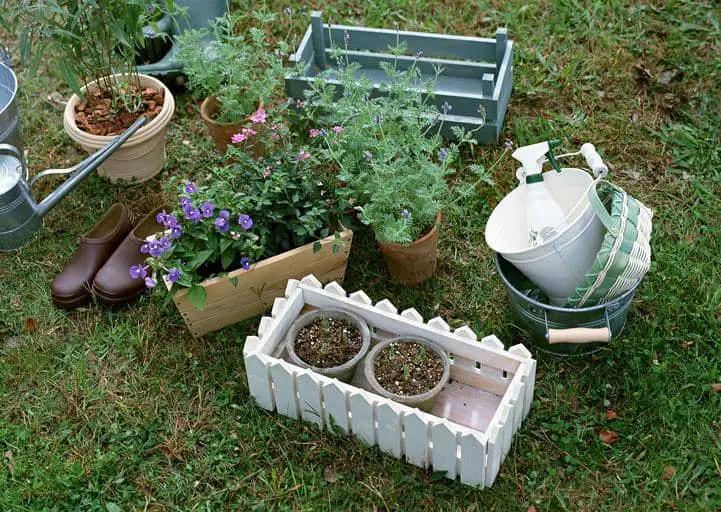Are you keen on becoming a gardener, but do not have enough space for a garden? Then a container garden is the thing for you. The main attraction of a container garden is that you can have a garden anywhere. Be it your backyard, porch, or the balcony, container gardens make your home attractive and beautiful.
Not only can you plant flowers in your container garden, but you can plant vegetables too. Worried that you won’t be able to successfully grow vegetables? Not to worry! You can easily grow a wide variety of vegetables, fruits, flowers, succulents, and herbs in a container garden.
![Choosing the Right Plants for Container Gardening [Level 101]](https://wraxly.com/wp-content/uploads/2021/06/Choosing-the-Right-Plants-for-Container-Gardening-Level-101.jpg)
Choosing the Right Plants for Container Gardening
If you would love herbs growing in your window box, some tomatoes on the balcony, or lavender around your porch, then a container garden is for you. Containers are an excellent way to beautify your house with flowers, and an easy way to enjoy the rewards of home-grown vegetables.
Container gardens, in addition to being handy, are also very visually appealing. They give the perfect look to your porch or apartment balcony, sprucing up your whole place. Container plants are also very easy to move around and do not need any heavy gardening tools.
The money you spend on your container garden depends entirely upon you. Vegetables, fruits, herbs, shrubs, dwarf trees, annuals, perennials, and drought resistant plants are some examples of what can be grown easily in a container garden.
Advantages of a Container Garden
Container gardens come with their own set of advantages.
- This type of gardening is best for those who do not have the necessary yard space for a garden. Container gardening can be easily done on a balcony or porch.
- Container gardens are also easily moved from one place to another. If you need sunlight or protection from the cold, you can easily get the plants indoors or outdoors.
- Container gardens will allow you to grow various plants with different soil needs, unlike a regular garden.
- Weeding is not required in a container garden. That is a big relief, isn’t it?
- Damage from pests is also minimal in a container garden. The plants get to grow up healthy.
- Container gardens are very versatile. You can build an indoor garden with container plants, which in turn will improve the air quality and lend a splash of color to your home.
- Think of the advantage of having herbs or vegetables right on your windowsill. Just pick some and make a great meal!
Disadvantages of a Container Garden
- Plants grown in containers tend to dry out easily, so watering them at regular intervals is an absolute must.
- You must also add fertilizers to the soil on a consistent basis. As composting and mulching does not work as well as in a normal garden, a fertilizer solution is the best bet.
- If you want to grow large amounts of vegetables or herbs for your own regular use, then container gardening is not for you. You will only be able to harvest a small quantity.
- Container plants are more vulnerable to cold, as they are not safeguarded by insulation from the soil around it. The same goes for the lack of water. Precipitation will not work on container gardens.
- Containers limit the growth of a plant, confining the roots and stunting it.
- Container plants will not get the beneficial manure from earthworms and other creatures.
How To Build A Container Garden
Building a container garden is easy. You just need to keep these elements in mind while planting.

- The container size is to be chosen first. Plants grow better in a large container than in a small one. Small containers usually restrict the root growth of a plant. The advantage of a large container lies in the fact that it holds more soil, keeping the plants saturated and moist for a longer period of time.
- Before planting, look at the container’s size and the plant to be potted. If the plant has an extensive root system, opt for a large container. Nevertheless, if the root system of the plant is shallow, a small pot will suffice.
- Purchase a high quality potting mix before potting your plants.
- Drainage is also an essential factor to be kept in mind while planting your container garden. Look for draining holes at the bottom of the container; otherwise, the excess water will cause waterlogging.
- When buying plants for your container garden, be sure to note if they will need sun or shade. If you buy sun loving plants and have shade in your garden, that won’t do at all.
- Keep track of the fertilization, pruning, and watering of the plants and maintain it regularly.
- Make your container garden in an area of your home that will accentuate it the best. Plant your garden and see the transformation in your home!
Choosing the Right Plants for a Container Garden
Choosing the right plants for your container garden is the key to your garden’s success. Not all plants do well in containers. I have listed below some plants that are best suited for a container garden.
Vegetables
Vegetables are a great addition in a container garden. You can have fresh produce straight from your garden. Think of pizzas topped with your favorite homegrown veggies. Some vegetables that do really well in container gardens are tomatoes, chives, squash, broccoli, carrots, chili peppers, cabbage, potatoes, radishes, bell peppers, salad cress, lettuce and eggplant.
Herbs
Herbs are another great addition to a container garden. The smell of fresh herbs is always invigorating. Herbs are used to garnish or flavor foods, give off a comforting fragrance, and most importantly, they are used as medicines too. Some herbs you can plant in your container garden are rosemary, basil, sage, mint, thyme, parsley, lemon balm and oregano.
Fruit
Fruits can be grown in a container garden too. You can plant apples, peaches, strawberries, plums, pears, blueberries, cherries, raspberries, figs and gooseberries.
HANDPICKED RELATED CONTENT: Growing Watermelon in Grow Bags
Shrubs
You can add shrubs to your container garden, which will lend a beautiful color and texture to your garden. It does not matter if you have a small place. Shrubs will enhance your environment. You can grow shrubs like boxwoods, hydrangea, roses, rhododendron, blue star juniper, and Japanese laurel.
Small Trees
You can also think of adding a small tree to your container garden. However, remember trees will need tree cultivators for planting in containers. Some trees like bay trees, olive, Japanese maple, and starry magnolia are great for planting in containers.
Annuals
Annuals are a great addition to container gardening. They will add color and charm to the whole place. Geraniums, petunias, verbena, marigold and coleus are some annuals you can plant in your container garden. However, remember that annuals need to be planted every year.
Perennials
Perennials are another great thing. They will add fantastic color and vibrancy to your whole garden. They also do not need to be replaced every year so it is a win-win situation. You can try perennials like lavender, chrysanthemums, primrose, foxglove, catmint, and coreopsis.
Succulents
If you do not wish to spend too much money and time on your container garden, consider planting drought-resistant succulents. They look attractive and conserve water. Cacti, aloe, agave, and jade are some good options.
Tips for Container Gardening
Once you get the hang of container gardening, you may want to add to your container garden every year. Below are some tips to remember for growing healthy plants in your container garden.

Purchase the Proper Soil
For a successful container garden, the soil needs to be good. Lighter soil mixes are the key to successful container gardening. Lighter soil allows for better air circulation and drainage. Both of them are essential for proper plant growth. In no condition should you use soil from your yard for your container garden. This soil will be too heavy, the water will not reach the roots, and there will be no proper circulation of air. It’s better to use lighter soil mixes for a thriving plant.
Tend to your Container Garden Watering Needs
One of the most important factors of successful container gardening is watering well. Make sure that the plants are amply watered. If plants get too much water, their roots will rot and soggy soil will not allow the plants to get oxygen from the soil. On the other hand, less water will make the plants wilt. So, always stay vigilant and water your plants well. Make sure the plants are draining properly too.
Don’t Forget to Fertilize Your Container Garden
Keeping your plants fed properly will help them grow. Feeding means fertilization. The easiest way to keep them fertilized is to use a potting mix with fertilizer. Make sure that there is not too much fertilizer though. (See: Tomato Tone vs. Garden Tone: Which One Is Better?)
You may also be interested in: 7 Easy Steps to Grow Sugar Snap Peas in Containers
Be Mindful of Your Plant’s Sun Requirements
Look for sunlight and shade requirements in your container plants. Monitor your plants regularly to see that they are getting the required amount of both. The foliage of a plant indicates how much sunlight it needs. Plants with greener leaves need less light. Plants with colored leaves need more sunlight. Too much or too less of either will result in droopy plants. Move the plants around as per their needs.
Watch for Pests and Diseases
Keep an eye out for pests and diseases in your container garden. Though container gardens get less pests than regular gardens, the threat is still there. Keep medications to ward them off your garden.
For a successful container garden, inspect your plants often. Check for browning, yellowing, or wilting leaves. Check stems and watch out for insect damage too. Also, make sure that the soil is not too wet or dry.
Consider a Light Colored Container
Additionally, you can go for light colored containers, as they absorb less heat than dark color ones and keep the roots cooler during summer.
Choose the Correct Size Container
Lastly, you must remember the most important thing to keep in mind when planting a container garden. Always make sure the size of the container complements the size of the plant. For example, you cannot plant tomatoes in a small pot. They will need space and stakes to grow to their full size. On the other hand, planting garlic in a large container will be a mistake. Garlic has short roots and thrives in small containers.
Final Thoughts on Choosing Plants for a Container Garden
Make sure you have done some research before you start planting your garden. Choosing the right plant for your container garden is of the utmost importance. Look at the various plants and the soil they will need, the fertilizer they will want, and the care they will necessitate, and then plan out your container garden. Create your own personal garden in your backyard, on your porch, or on your balcony!

Darrell has a passion for gardening that he inherited from his father. Go here to read more about the influence his father played in his love for gardening. If you want to send Darrell a quick message, then visit his contact page here.

![How to Water Indoor Plants [Plant Care 101]](https://wraxly.com/wp-content/uploads/2021/03/How-to-Water-Indoor-Plants-Plant-Care-101-1200-1024x576.webp)

![Growing Plants from Cuttings [A Simple Guide]](https://wraxly.com/wp-content/uploads/2021/03/Growing-Plants-from-Cuttings-A-Simple-Guide-1200-1024x576.webp)